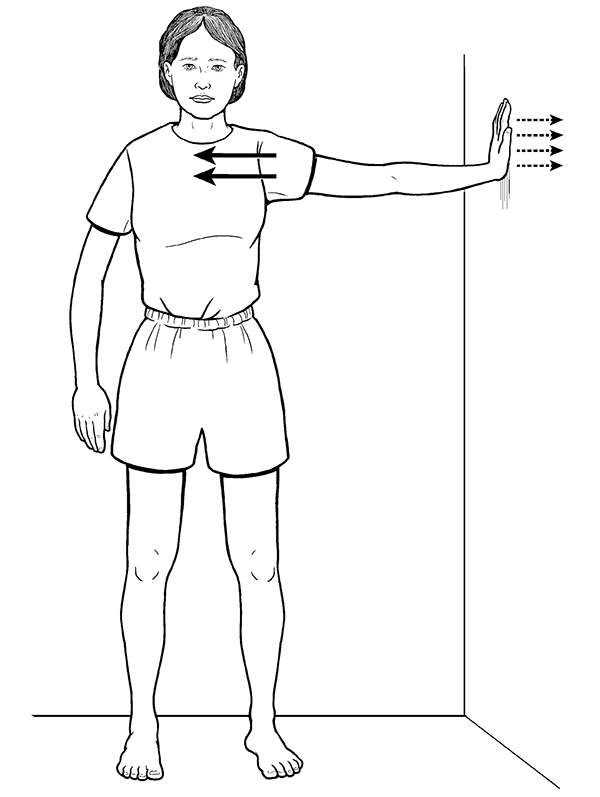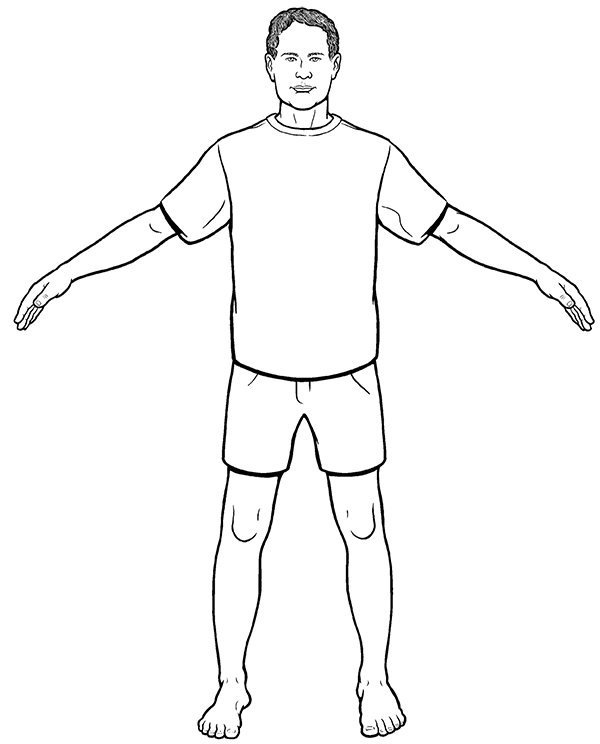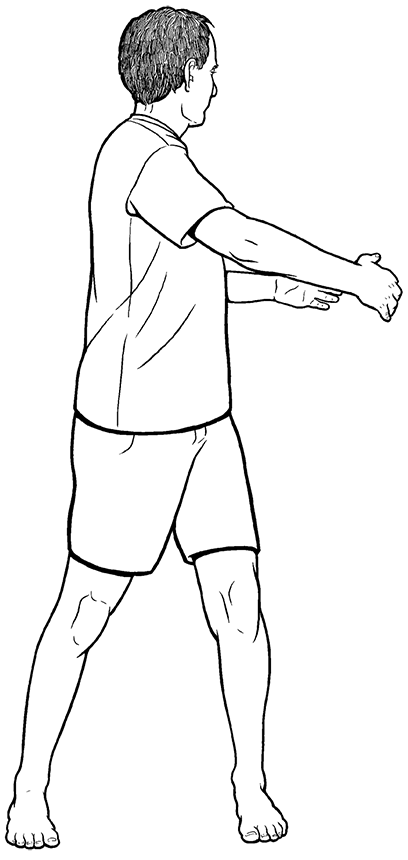Read Chinese Healing Exercises Online
Authors: Steven Cardoza
Tags: #Taiji, #Qi Gong, #Daoist yoga, #Chinese Healing, #Health, #medicine, #remedy, #energy
Chinese Healing Exercises (17 page)
Figures 5.11 and 5.12 (Interlocking Fingers behind BackâA Shoulder Stretch)
Variation:
If your fingertips can't touch behind your back, use this variation. Hold a small towel (or a belt or short length of rope) in your right hand. As you reach behind your back with your right hand, grab the towel firmly with your left. Pull up on the towel with your left arm, “choking up” on the towel as you do, so that the length of towel between your hands becomes less. Hold the stretch once you've increased it to your current comfortable limit
(
Fig 5.12
).
With the stretch held with interlocked fingers or a towel, begin directed breathing into the stretch. Do your best to let any feeling of tension release with each exhale. If you are using a towel, hold the stretch for at least thirty seconds, and gradually increase the amount of time as your body opens more fully. If you have your fingers interlocked, you can hold the stretch longer from the start, for up to two minutes.
12. Nerve and Meridian Stretch/Release
Purpose (Physical and Energetic)
Heart disease is one of the major killers in the United States and other developed countries. This exercise both brings an increased awareness into body parts related to heart health (associated meridians and nerves) and gives people a tool, a way to use that awareness to reverse some of the contributing factors to heart disease. A common symptom of heart attack, for example, is the sensation of pain running down the left arm, and often also the right arm. This symptom is universally observed and agreed upon by medical professionals. Less well-known by most people: that arm pathway corresponds to the external portion of the Heart meridian, which is used to treat Heart problems of various descriptions. Keeping that meridian open, freely transporting qi through its length, is necessary to maintaining heart health, and may prevent the occurrence of some heart diseases.
Unlike other stretches presented here, this one does not directly target muscles, although they are influenced to some degree. Here the stretch focuses on nerve and meridian pathways, and on fascia (the tough, thin membranous tissue that surrounds muscles and organs), particularly the palmar aponeurosis covering the palm of the hand. While qi has some specific trajectories, traveling along discrete meridian pathways, it also travels freely and diffusely through all other parts of the body. The fascia provides a layer of physical tissue for one such diffuse network. The sensation of stretched nerve and fascia is very different than that of muscles, and this gives you one access point to that distinction.
Techniques used
Nerve and fascia stretch, nerve and qi awareness/sensitization, focused breathing.
Method
Stand facing an unobstructed wall, about an arm's length away from it. To stretch your left arm, turn your whole body 90 degrees to the right, so that your left shoulder is now toward the wall. Raise your left arm and place your palm on the wall, fingers pointing straight up toward the ceiling. Make sure the whole surface of your palm touches the wall, with the possible exception of the concavity at the very center of your palm. Also make sure that your arm is relaxed, and the tip of your elbow is pointing toward the ground and not locked. Use your mind to feel an almost magnetic attraction between your palm and the wall, creating a light sense of attachment so that you don't have to exert any effort to hold your arm up, and so that the weight of your arm does not pull your palm down or off of the wall. You may already feel the effects of the stretch as a light burn at your palm and along the length of your arm.
To increase the stretch, maintain the sense of magnetic attraction between your palm and the wall, and while keeping your body perpendicular to the ground (in other words, don't lean), move very slightly away from the wall, maybe just
1
â
8
to
1
â
4
inch. This will remove a bit more slack from your arm, stretching the nerve and meridian pathway
(
Fig 5.13
).
There should not be a sense of pushing your palm into the wall. It's more like a pulling away, but do not let any part of your palm leave the wall, do not let your elbow lock, and keep your elbow tip pointed toward the ground. Now you should clearly feel a burn at the palm of your hand, along the bottom surface of your arm, or both. That burn is from the nerve and fascia stretch.
Because everyone's physiology is slightly different, you may need to roll your arm so that your elbow tip points a little toward the front or rear of your body, but only just a little, and while continuing to keep your palm fully contacting the wall. Only do this in order to increase the burn sensation if it is not already present, and that will indicate that you are now in fact stretching the nerve and fascia. Once you have the burn, hold the stretch for up to two minutes, breathing slowly and deeply while encouraging your arm to relax further with each exhalation. In previous stretches, the breath-directed relaxation primarily targeted tight muscles. Here, it is targeting the nerve and fascia.
To stretch your right arm, lower your left arm from the wall, turn to the left so that your right shoulder is now facing the wall, and repeat the above with your right arm.
 Figure 5.13 (Nerve and Meridian Stretch/Release)
Figure 5.13 (Nerve and Meridian Stretch/Release)
Six
Back, Pelvis/Hips, and Spine
Our back is one of the most important external parts of our body, and is often the most overlookedâuntil it hurts. Relative to the front of the bodyâwhich is softer, more vulnerable, and allows easier access to most internal organsâthe back is tougher, harder, and more protective, both physically and energetically. This is in keeping with the Chinese understanding that the back of the body is more Yang, while the front of the body is more Yin. In Western understanding, this is expressed colloquially when someone is feeling weak or frightened and may want to “curl up in a ball” or “revert to a fetal position.” When one is physically under assault by an animal or some other attacker they may be unable to fight against, curling up in a ball is a natural self-protective response to that danger.
The vertebrae (the bones of the spinal column) are dense bones, and their rounded structure effectively shields the soft spinal cord within. At the rear of each vertebra is a protrusion called the spinous process, the bony tip of the vertebra which is what is felt along the center of the back. In addition to being an attachment point for various muscles, the spinous process provides an extra measure of protection against any force that may strike the back. Tough ligaments “knit” the vertebrae together, providing greater flexible stability. Between each two vertebrae are cartilaginous discs, tough on the surface and springy on the inside, to provide cushioning and shock absorption between vertebrae. Dense muscles flank the vertebral column, and broad dense muscles cover the entire back and ribcage; both provide further structural support and create motion in every plane. Each rib also articulates with (touches and attaches to) the sides of the vertebrae, and there are muscles and cartilage between each rib. While just a very general description of the structure of the back, this should give you a good idea of its protective design.
Within the vertebral column is the spinal cord, the nervous system's main “information superhighway,” allowing the brain to communicate with virtually everything in the body. Spinal nerves exit the spinal cord between each vertebra, sending functional information to every part of the body to make sure every organ, muscle, and other body tissues are working properly. They also receive sensory information so the subconscious, automatic parts of the brain can make appropriate decisions based on what the body has to report about itself and the environment, and they inform our conscious mind so we can actively make the best choices for ourselves.
On a purely energetic level, the Du meridian, or Governing Vessel, runs upward behind the center of the spine, and governs all the Yang aspects of the body, fully one-half of all body processes and activities. Along the Du meridian are numerous conventional acupuncture points, some of which correspond to various developmental stages of the trajectory of one's life, more of a spiritual consideration. At the center of the top of the head, there is a point on the Du meridian called Bai Hui, or “One-hundred Convergences,” both a direct and an indirect meeting point for all the most prominent energy lines in the body. These are just a couple of ways to demonstrate the influence of the Du meridian, which extends much farther throughout both the physical and the spirit body than you might expect, and includes many aspects of mental functioning.
Flanking the spine are two branches of the Urinary Bladder (UB) meridian, the inner branch being about 1
1
â
2
inches from the center of the spine, and the outer branch being about 3 inches out. The inner branch of the UB meridian has points which influence the function of every internal organ, including the respiratory diaphragm. Those points almost
entirely correspond to the locations of the spinal nerves that influence the same organs. The
outer UB line contains points that influence the emotional energies associated with the various organs, and some have a connection with spiritual energies too.
From this you can see how the health of the back and spine influences the health of the entire body. If an injury causes a muscle spasm or damage to a vertebra or disc, or inactivity causes increasingly tight back muscles and spinal compression and those or any number of other possible back problems go uncorrected, much of the life energy at those points is shut off. Degeneration sets in, and aging is accelerated. According to Chinese medicine, the Kidneys, which reside in the low back, are responsible for much of our vitality, sexual energy, the health of all the bones in the body (including the teeth), aspects of hearing, and the manifestation and condition of head hair, as well as the commonly understood functions associated with detoxification and fluid metabolism as regulated through the urinary tract. These are all things we see commonly affected by age. In the context of the exercises presented in this book, taking care of your back may be the single most important thing you can do to stay healthy and vital, and slow the aging process.
1. Torso Twist with Arm Swing
Purpose (Physical and Energetic)
This exercise is a convenient linking exercise with the previous arm and shoulder set, but may be practiced at the very beginning of an exercise session to warm up and vitalize much of the entire body, or can be done at any time as a stand-alone exercise as a general tonic
and antidote to too much sitting. With practice, you can use it to “pump” and massage the
inguinal lymph glands, benefiting the immune system. It is often used as a warm-up before
doing a taiji set. Some people may recognize this as similar to the First Arm Swing of the
Three Arm Swings of the Energy Gates qigong set, but it is not the same thing. This version is simpler, does not contain the neigong aspects of the First Arm Swing, but does offer more benefit to all the physical structures of the back. By extension, the energetics discussed in the introduction to this section are also benefited. All of the vertical acupuncture meridians of the back (Du and UB) and core meridians are stimulated, as well as the horizontal Dai meridian. Paidagong, slapping and patting, additionally dislodges stagnant qi around the kidneys and low back. When done vigorously, it is also a very safe zero-impact aerobic exercise.
Techniques used
Joint mobilization of the spine and shoulders; stretching of most of the torso muscles, legs, and arms; induction of qi through all of the meridians; paidagong.
Method
Stand with your feet parallel, slightly wider than shoulder width apart. Make sure there is no furniture, person, or any other type of obstruction within extended arms' length. Imagine a pole running perpendicularly through the center of your body, and turn your torso around that pole, first to one side and then the other. Keep your arms completely relaxed, hanging loose at your sides
(
Fig 6.1A
).
Stay perpendicular to the ground; do not lean from side to side. Feel the vertebrae rotate over each other and the attached back muscles stretch as you turn. The muscles around your waist will also stretch with the twist. Turn your head in the same direction as your torso so that your neck also fully pivots around that center pole. Try to look at the wall directly behind you by the endpoint of the turn in both directions
(
Fig 6.1B
and
Fig 6.1C
).
Gradually turn faster so that your relaxed arms raise from the motion of the turn only. Do not use any effort to raise your arms.
If you want, you may increase the power of the turn by shifting your weight to your left leg as you turn left, and then to your right leg as you turn right, still without leaning. That may give you a sense of springiness in your legs as you turn side to side, and blood flow through your legs will increase. If you are able to feel that, you are also massaging the inguinal lymph glands, benefiting your entire immune system. As you turn faster and with more power, your arms will raise higher. Your hands will begin to slap and tap your body, starting at your thighs and hips, but in time and with practice, they'll rise to the height of your low back and the top of your pelvis. The tapping and patting should feel comfortable, not forced, hard, or painful.
There's no set amount of time to do this. As a warm-up, or contained within an exercise set, one to two minutes can be enough, although longer is fine. If you do this as a stand-alone practice, you may want to do it for five minutes or more. Let your senses be your guide. At the completion of the Torso Twist, your back, waist, and arms should feel loose, energized, open, and relaxed.
 Figure 6.1A (Torso Twist with Arm Swing)
Figure 6.1A (Torso Twist with Arm Swing)


Figures 6.1B and 6.1C (Torso Twist with Arm Swing)
Variations
Variation One: Hug a Tree and Lead with Elbows:
In this variation of the Torso Twist, you can target select vertebrae that may feel particularly stuck or tight, if they fall between the range of the height of your shoulders and elbows when your arms are at your sides. Otherwise, the purpose and techniques used are the same as in the primary version. Most of the method is the same except as follows.



